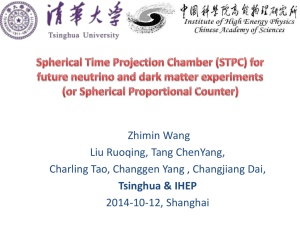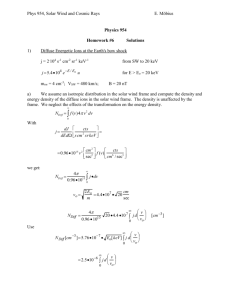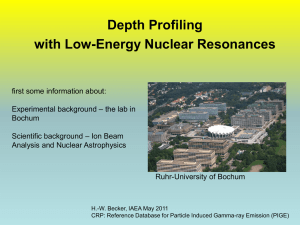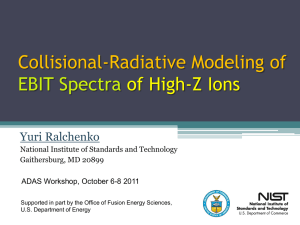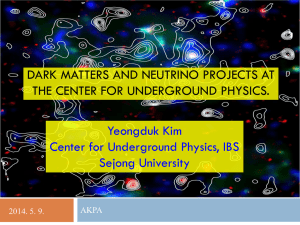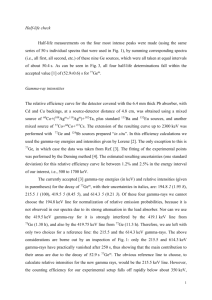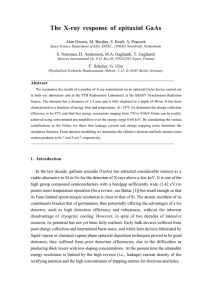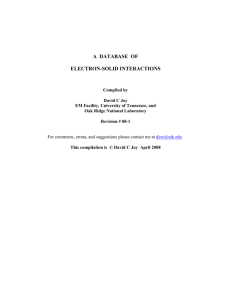Collective Model
advertisement
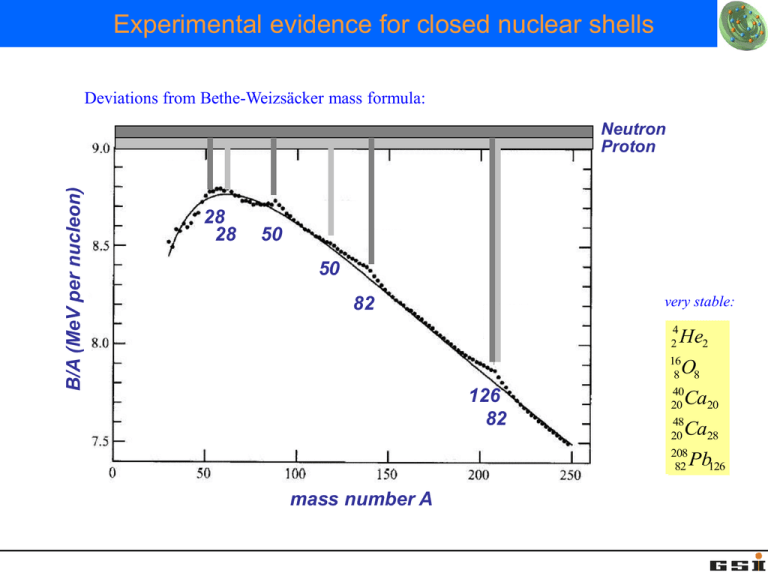
Experimental evidence for closed nuclear shells Deviations from Bethe-Weizsäcker mass formula: B/A (MeV per nucleon) Neutron Proton 28 28 50 50 82 very stable: 4 2 He2 16 8 8 40 20 20 48 20 28 208 82 126 O 126 82 Ca Ca Pb mass number A Shell structure from masses • Deviations from Weizsäcker mass formula: Energy required to remove two neutrons from nuclei (2-neutron binding energies = 2-neutron “separation” energies) N = 82 25 23 21 N = 126 S(2n) MeV 19 17 15 13 Sm 11 Hf 9 Ba N = 84 7 Pb Sn 5 52 56 60 64 68 72 76 80 84 88 92 96 100 Neutron Number 104 108 112 116 120 124 128 132 Shell structure from Ex(21) and B(E2;2+→0+) high energy of first 2+ states low reduced transition probabilities B(E2) The three faces of the shell model Average nuclear potential well: Woods-Saxon A A pˆ i2 ˆ H Vˆ ri , rj i 1 2mi i j A A pˆ i2 A ˆ ˆ ˆ H V ri V ri , rj Vˆ ri i 1 2mi i 1 i j 2 2 V r r 0 2m r u r Y m , X ms r V r V0 /1 expr R0 / a Woods-Saxon potential Woods-Saxon gives proper magic numbers (2, 8, 20, 28, 50, 82, 126) Meyer und Jensen (1949): strong spin-orbit interaction 2 2 V r Vs r s r 0 2 m 1 dV Vs r ~ r dr mit 0 dV r dr V r Spin-orbit term has its origin in the relativistic description of the single-particle motion in the nucleus. r Woods-Saxon potential (jj-coupling) 1 s j 2 2 s2 2 j s 2 1 j j 1 1 s s 1 2 2 The nuclear potential with the spin-orbit term is V r Vs 2 V r 1 Vs 2 for j 1/ 2 for j 1/ 2 spin-orbit interaction leads to a large splitting for large ℓ. j 1 / 2 j 1 / 2 j 1 / 2 1 / 2 Vs / 2 Vs Woods-Saxon potential The spin-orbit term 1 2 Es 1 2 2 1 2 Vs 2 reduces the energy of states with spin oriented parallel to the orbital angular momentum j = ℓ+1/2 (Intruder states) reproduces the magic numbers large energy gaps → very stable nuclei Important consequences: Reduced orbitals from higher lying N+1 shell have different parities than orbitals from the N shell Strong interaction preserves their parity. The reduced orbitals with different parity are rather pure states and do not mix within the shell. Shell model – mass dependence of single-particle energies Mass dependence of the neutron energies: E ~ R 2 Number of neutrons in each level: 2 2 1 ½ Nobel price in physics 1963: The nuclear shell model Experimental single-particle energies γ-spectrum single-particle energies 1 i13/2 1609 keV 2 f7/2 896 keV 1 h9/2 0 keV 209 83 Bi126 208Pb → 209Bi Elab = 5 MeV/u Experimental single-particle energies γ-spectrum 208Pb single-hole energies 3 p3/2 898 keV 2 f5/2 570 keV 3 p1/2 0 keV 207 82 Pb125 → 207Pb Elab = 5 MeV/u Experimental single-particle energies particle states 209Bi 2 f7/2 1609 keV 896 keV 1 h9/2 0 keV 1 i13/2 208 82 209Pb energy of shell closure: Pb126 BE(209Bi) BE(208Pb) E(1h9 / 2 ) BE(207Tl ) BE(208Pb) E(3 s1/ 2 ) E 1h9 / 2 E (3 s1/ 2 ) BE( 209Bi) BE( 207Tl ) 2 BE( 208Pb) 4.211MeV 207Tl 207Pb BE(209Pb) BE(208Pb) E(2 g9 / 2 ) hole states proton BE(207Pb) BE(208Pb) E(3 p1/ 2 ) E 2 g9 / 2 E (3 p1/ 2 ) BE( 209Pb) BE( 207Pb) 2 BE( 208Pb) 3.432 Level scheme of 210Pb 2846 keV 2202 keV 1558 keV 1423 keV 779 keV 0.0 keV -1304 keV (pairing energy) M. Rejmund Z.Phys. A359 (1997), 243 209 82 Pb127 Level scheme of 206Hg 2345 keV d3/12 d5/12 s1/12 d5/12 207 81 Tl126 1348 keV 997 keV 0.0 keV B. Fornal et al., Phys.Rev.Lett. 87 (2001) 212501 Success of the extreme single-particle model Ground state spin and parity: Every orbit has 2j+1 magnetic sub-states, fully occupied orbitals have spin J=0, they do not contribute to the nuclear spin. For a nucleus with one nucleon outside a completely occupied orbit the nuclear spin is given by the single nucleon. nℓj→J (-)ℓ = π Success of the extreme single-particle model magnetic moments: The g-factor gj is given by: j g g s s g j j 2 with 2 j s j 2 2 j s s 2 j j j j g g s s j j 2 s 2 j j 2 2 j 2 g j j 1 1 3 / 4 g s j j 1 1 3 / 4 j 2 j j 1 1 1 1 s s 1 g j g g s g g s 2 2 j j 1 Simple relation for the g-factor of single-particle states g g g Kern g s K 2 1 for j 1/ 2 Success of the extreme single-particle model magnetic moments: 1 1 g j g s K 2 2 z j g j 3 1 g s K j 1 2 2 j 1/ 2 für j 1 / 2 für g-faktor of nucleons: proton: gℓ = 1; gs = +5.585 neutron: gℓ = 0; gs = -3.82 proton: für j 2.293 K j z j 2.293 K für j 1 neutron: für 1.91 K j z 1.91 K für j 1 j 1 / 2 j 1/ 2 j 1 / 2 j 1/ 2 Magnetic moments: Schmidt lines magnetic moments: proton magnetic moments: neutron
